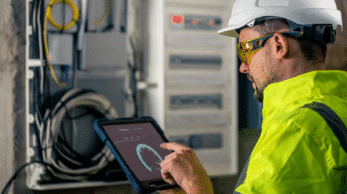A preventive maintenance plan aims to maintain equipment reliability, minimize operational disruptions, and optimize the management of your physical assets. Accurately knowing each piece of equipment and following the manufacturer’s recommendations is the foundation for developing an effective program.
Your preventive maintenance plan in 5 steps
1. Identify and prioritize equipment for preventive maintenance
The first step in developing an effective preventive maintenance plan is to perform a comprehensive inventory of your assets and assess their strategic importance to operations. Inventory is the cornerstone of any maintenance strategy.
It allows you to centralize all information related to your equipment, including:
- Technical specifications (model, serial number, year of commission).
- Maintenance history (last interventions, recurring failures).
- Maintenance priorities based on FMEA and the ABC method.
FMEA helps you identify potential failures of each piece of equipment, assess their impact on safety, production, and costs, and establish a priority order for preventive interventions. The ABC method can also be used to complement this analysis by categorizing equipment into three categories (A, B, C) according to their importance in the overall process. This allows for a clear prioritization of maintenance resources and efforts.
2. Schedule Interventions
Creating a maintenance schedule allows organizing interventions based on the criticality of the equipment and their current condition. Here are the main approaches for establishing this schedule:
- Following manufacturer recommendations: Manufacturers usually provide maintenance schedules based on time or usage, specifying how often certain tasks should be performed. This may include tasks like changing filters, lubricating, or visual inspections.
- Maintenance history and sensor data: Analyzing the history of failures and past maintenance can reveal patterns to help anticipate future failures. In addition, using IoT sensors can provide real-time information on equipment’s condition, allowing for a predictive maintenance approach.
- Criticality-based approach (FMEA method): As previously seen, critical equipment requires priority attention. Depending on each equipment’s impact on production and safety, the maintenance frequency can be adjusted.
3. Design Standardized Procedures
Each maintenance task should be described in a clear and standardized procedure. These procedures should include:
- Detailed steps: Describe the actions to be performed, from preparation (equipment shutdown, tool verification) to completion (testing, restarting).
- Safety instructions: Each procedure must include instructions on securing interventions to avoid any accidents or damage.
- Estimated duration of the intervention: Estimate the time required to perform each task and the potential impacts on production.
- List of necessary tools and parts: Ensure that technicians have access to the right tools and spare parts at the right time to prevent interruptions in the intervention.
4. Manage Resources and Skills
For maintenance to be effective, it is important to properly manage human and material resources:
- Assignment of qualified technicians: Interventions must be carried out by technicians with the skills required for each type of equipment. Ongoing training is vital to ensure that the maintenance team stays up-to-date on procedures and new equipment.
- Spare parts management: A good maintenance program also includes effective management of spare parts inventory. This prevents unnecessary delays due to the unavailability of required parts.
- Tracking and updating interventions: Keeping a record of all performed interventions, including observations, encountered problems, and corrective actions taken, is essential. This data helps track equipment performance and adapt future maintenance.
5. Establish KPIs for Performance Monitoring
Among the key performance indicators in maintenance, we find:
- MTTR (Mean Time To Repair): Average time to repair, which helps measure maintenance intervention effectiveness.
- MTBF (Mean Time Between Failures): Average time between failures, an indicator of equipment reliability.
- Availability rate: The percentage of operational time compared to total available time.
- Maintenance costs: Tracking direct and indirect costs associated with equipment maintenance.
How can a CMMS simplify and improve your Preventive Maintenance Plan?
A CMMS (Computerized Maintenance Management System) can transform your maintenance management by centralizing information, improving the visibility of operations, and customizing interventions according to specific needs. It also facilitates integration with other systems for more consistent and efficient asset management.
A Computerized Maintenance Management System (CMMS) is an invaluable asset for automating scheduling and ensuring accurate tracking of each intervention. A CMMS allows you to:
- Automate maintenance reminders: Automatically schedule interventions based on the established schedule or real-time data from IoT sensors.
- Manage resources: Track the availability of technicians and the status of spare parts inventory.
- Analyze performance: Collect and analyze maintenance data to optimize future planning and detect trends that could improve equipment reliability.
Implementing a structured preventive maintenance plan, supported by an efficient CMMS, can significantly reduce your costs, limit interruptions, and prolong the lifespan of your equipment. This is now an integral part of proactive corporate strategies to improve operations and financial outcomes.






